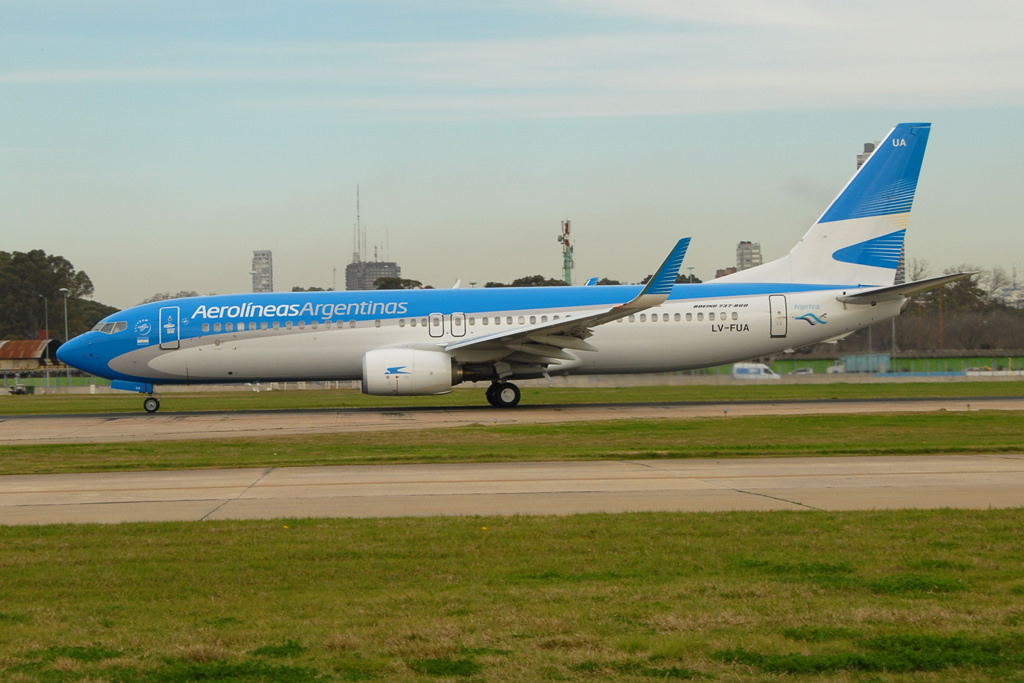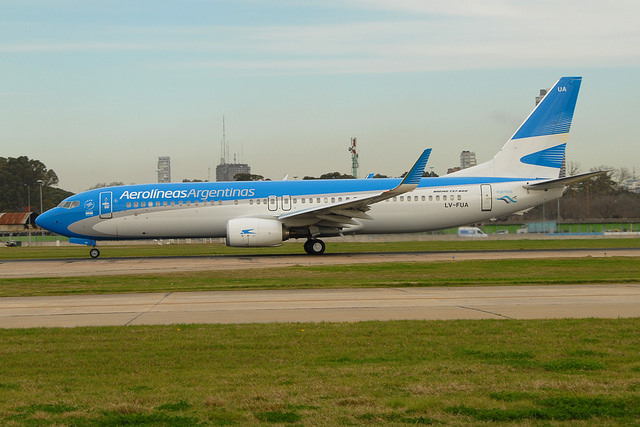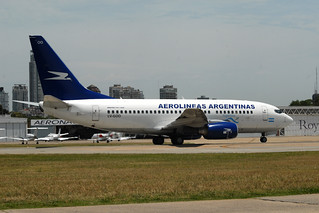Aerolineas B738 at Bariloche on Feb 13th 2017, tail strike on go-around
Last Update: February 15, 2019 / 20:30:23 GMT/Zulu time
Incident Facts
Date of incident
Feb 13, 2017
Classification
Accident
Airline
Aerolineas Argentinas
Flight number
AR-1672
Departure
Buenos Aires Aeroparque, Argentina
Destination
Bariloche, Argentina
Aircraft Registration
LV-FUA
Aircraft Type
Boeing 737-800
ICAO Type Designator
B738
Argentina's JIAA reported the aircraft received damage on landing attempt at about 16:30Z, an investigation has been opened.
On Feb 15th 2019 Argentina's JIAA released their final report in Spanish (Editorial note: to serve the purpose of global prevention of the repeat of causes leading to an occurrence an additional timely release of all occurrence reports in the only world spanning aviation language English would be necessary, a Spanish only release does not achieve this purpose as set by ICAO annex 13 and just forces many aviators to waste much more time and effort each in trying to understand the circumstances leading to the occurrence. Aviators operating internationally are required to read/speak English besides their local language, investigators need to be able to read/write/speak English to communicate with their counterparts all around the globe). The report concludes (basically reiterating the whole flight from Adam and Eve to date but NOT working out the causes of the accident, hence the following is a meaningful summary of the conclusions spanning more than 3 pages, not a translation):
Following an unstabilized approach, the stabilized or non-stabilized call missing, the aircraft touched down with engine thrust higher than idle and without flare resulting in the aircraft bouncing off up to 4 feet AGL. Engine thrust was reduced to idle during the bounce causing the spoilers to extend resulting in sudden loss of lift, the aircraft contacted the runway surface at +3.08G and remained on the ground, a go around was initiated reaching a pitch attitude of 8.6 degrees nose up, less than the 9.2 degrees nose up required for a tail strike according to Boeing. Due to high vertical load of +3.08G and the resulting gear compression suggests that the tail strike could occur at a lesser pitch angle than Boeing determined as limit for tail strikes, however, empirical evidence available does not permit to conclude whether the tail strike occurred as result of the go-around or the hard touchdown following the bounce.
Contributing to the accident was:
- the operator within its SMS programme did not evaluate the operational performance of flight crews.
- Guidelines for Human Factors issued by Argentina's ANAC have not been updated since its initial publication in 1997.
- A query by the JIAA to Boeing about similiar events and assessment, why the tail strike of AR-1672 occurred at a lower pitch angle than provided by Boeing did not bring up additional information due to the absence of similiar events in the manufacturer's files.
The JIAA reported the captain (42, ATPL, 4,800 hours total, 2,544 hours on type) was pilot flying, the first officer (37, ATPL, 3,608 hours total, 1,821 hours on type). The flight was uneventful until final visual approach to runway 29 assisted by ILS and PAPI indications, which was performed in manual mode with the autopilot disengaged. Although the speed was stabilized, the vertical profile was not, the vertical speed varied between 1000 fpm and 1608 fpm below 1000 feet AGL, no call out "stabilized" or "non-stabilized" was made. As result the aircraft bounced on first touchdown and touched down hard a second time and remained on the ground, the crew subsequently initiated a go around (balked landing). The second approach and landing was normal. Following landing the crew requested maintenance to inspect the aircraft for damage, maintenance found tail strike damage, the return flight was cancelled.
The aircraft received substantial damage to the underside of the fuselage including deformation of 4 ribs.
The weather was not relevant for the occurrence.
The flight data recorder showed the aircraft passed the point 5.8km (3.13nm) before the runway threshold at 1500 feet AGL, which should have been passed at 1000 feet AGL according to the 3 degree glidepath, the aircraft crossed 1000 feet AGL at 1100 fpm sinkrate, the sink rate increased to 1608 fpm at about 500 feet AGL, the aircraft joined the vertical profile about 1.45nm before the runway threshold, the sinkrate reduced to 200 fpm at 250 feet AGL and increased again to 976fpm at 136 feet AGL. The aircraft crossed the runway threshold at 40 feet AGL at 800 fpm and 140 KIAS and touched down at 131 KIAS about 250 meters past the threshold at 5.6 degrees nose up, engines at 66% N1 and a vertical acceleration of +1.97G. The aircraft bounced reaching a height of 4 feet, touched down a second time at 3.08G at 3.5 degrees nose up and 49% N1, the aircraft remained on the ground, the engines accelerated to 103% N1, the pitch increased to 8.6 degrees nose up, at which point the tail strike occurred.
The JIAA analysed that the approach must be and remain stabilized below 1000 feet AGL (according to the operator's standard operating procedures), otherwise a go around is to be performed. The standard operating procedure also required that upon the 1000 feet automated call the crew had to determine whether the approach was stabilized or not and react with an according call out. AR-1672 did not meet the criteria of a stabilized approach, however, the cockpit voice recorder did not register an according call out. Although the speed remained within the criteria for a stabilized approach (as the only criterium), the pitch angles varied between 2.5 degrees nose down and 2.8 degrees nose up, the engines varied between 50 and 70% N1.
Three criteria are necessary for the spoilers to deploy: engine thrust reduced to idle, gear struts compressed, main wheels spinning at more than 60 knots.
When the aircraft bounced the gear struts were compressed and the main wheels had spun up to more than 60 knots. When subsequently the engine thrust was reduced to idle, the third condition was met and the spoilers deployed causing the sudden loss of lift and the hard touch down. The deployment of spoilers also induced a nose up pitch moment that combined with the initiation of the go around resulted in the aircraft reaching 8.6 degrees nose up. According to Boeing a tail strike is possible only at 9.2 degrees nose up or more. Considering however, that the vertical acceleration of +3.08G on second touchdown compressed the gear strut shock absorbers beyond their operational envelope. This permits the hypothesis that due to this compression the aircraft's tail strike occurred at a lower pitch angle than certified by Boeing. However, the evidence available does not permit to reliably conclude why the tail strike occurred at less than 9.2 degrees nose up.
Metars:
SAZS 131800Z 00000KT 9999 NSC 28/04 Q1014
SAZS 131700Z VRB03KT 9999 NSC 26/04 Q1015
SAZS 131600Z 00000KT CAVOK 25/04 Q1016
SAZS 131500Z 00000KT CAVOK 23/03 Q1017
SAZS 131400Z 18004KT CAVOK 21/04 Q1018
SAZS 131300Z 14003KT CAVOK 18/04 Q1018
SAZS 131200Z 16005KT CAVOK 16/05 Q1018
Incident Facts
Date of incident
Feb 13, 2017
Classification
Accident
Airline
Aerolineas Argentinas
Flight number
AR-1672
Departure
Buenos Aires Aeroparque, Argentina
Destination
Bariloche, Argentina
Aircraft Registration
LV-FUA
Aircraft Type
Boeing 737-800
ICAO Type Designator
B738
This article is published under license from Avherald.com. © of text by Avherald.com.
Article source
You can read 2 more free articles without a subscription.
Subscribe now and continue reading without any limits!
Read unlimited articles and receive our daily update briefing. Gain better insights into what is happening in commercial aviation safety.
Send tip
Support AeroInside by sending a small tip amount.
Related articles
Argentinas B738 at Buenos Aires on Aug 14th 2018, bird strike
An Aerolineas Argentinas Boeing 737-800, registration LV-FUA performing flight AR-1878 from Buenos Aires Aeroparque,BA to Ushuaia,TF (Argentina), was…
Aero VIP D228 at Cascais on Apr 14th 2016, bird strike
An Aero VIP Dornier DO-228, registration CS-DVU performing a scheduled flight from Vila Real to Viseu (Portugal) and further on to Cascais (Portugal)…
Aerolineas B738 near Neuquen on Feb 13th 2024, cabin pressure problems
An Aerolineas Argentina Boeing 737-800, registration LV-FRQ performing flight AR-1639 from Bariloche,RN to Buenos Aires Ezeiza,BA (Argentina), was…
Argentinas B737 near Cordoba on Nov 5th 2023, engine shut down in flight
An Aerolineas Argentinas Boeing 737-700, registration LV-GOO performing flight AR-1471 from Jujuy,PJ to Buenos Aires Aeroparque,BA (Argentina) with…
Argentinas B738 near Posadas on Jun 19th 2023, burning odour on board
An Aerolineas Argentinas Boeing 737-800, registration LV-FSK performing flight AR-1740 from Buenos Aires Aeroparque,BA to Iguazu,MI (Argentina), was…
Argentinas B738 enroute on May 24th 2023, hail strike
An Aerolineas Argentinas Boeing 737-800, registration LV-GGK performing flight AR-1474 Buenos Aires Ezeiza,BA to Jujuy,PJ (Argentina) with 6 crew,…
Newest articles
Dana MD82 at Lagos on Apr 23rd 2024, runway excursion
A Dana Air McDonnell Douglas MD-82, registration 5N-BKI performing flight 9J-352 from Abuja to Lagos (Nigeria) with 83 people on board, landed on…
THY B773 at Tokyo on Apr 20th 2024, approached wrong runway
A THY Turkish Airlines Boeing 777-300, registration TC-JJT performing flight TK-198 from Istanbul (Turkey) to Tokyo Haneda (Japan), was cleared to…
Subscribe today
Are you researching aviation incidents? Get access to AeroInside Insights, unlimited read access and receive the daily newsletter.
Pick your plan and subscribePartner

A new way to document and demonstrate airworthiness compliance and aircraft value. Find out more.

ELITE Simulation Solutions is a leading global provider of Flight Simulation Training Devices, IFR training software as well as flight controls and related services. Find out more.

Your regulation partner, specialists in aviation safety and compliance; providing training, auditing, and consultancy services. Find out more.
AeroInside Blog
Popular aircraft
Airbus A320Boeing 737-800
Boeing 737-800 MAX
Popular airlines
American AirlinesUnited
Delta
Air Canada
Lufthansa
British Airways





